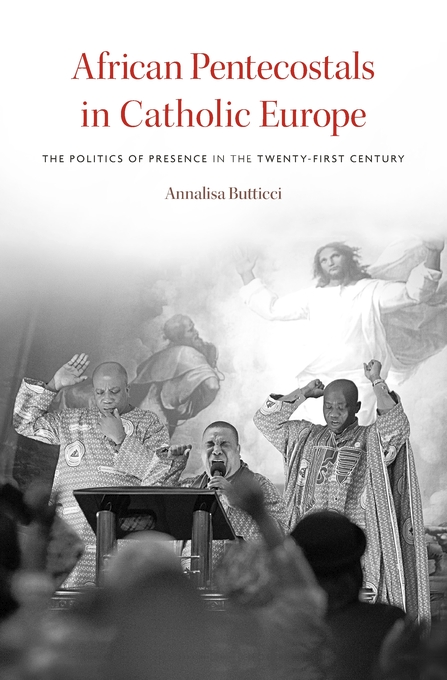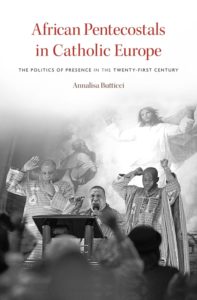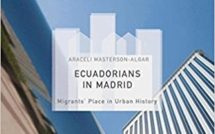
African Pentecostals in Catholic Europe: The Politics of Presence in the Twenty-First Century by Annalisa Butticci
 In the African American Methodist Church my family attended, it was not uncommon for a member of the congregation to “get the spirit” of the Holy Ghost, especially when the choir would fill the air with the familiar sounds of a favorite hymn. Church nurses all dressed in white would escort those transfixed by their singular experience to a discrete space where they might recover in silence. This moment of the convergence of the ordinary with Grace was seen as a welcome guest in the rhythm of the service, but was rarely commented on afterwards, as if,one could not speak of the Lord’s work so close at hand. And yet there was an understanding that the working of the Holy Ghost through the congregation was an intimate part of our religious tradition.
In the African American Methodist Church my family attended, it was not uncommon for a member of the congregation to “get the spirit” of the Holy Ghost, especially when the choir would fill the air with the familiar sounds of a favorite hymn. Church nurses all dressed in white would escort those transfixed by their singular experience to a discrete space where they might recover in silence. This moment of the convergence of the ordinary with Grace was seen as a welcome guest in the rhythm of the service, but was rarely commented on afterwards, as if,one could not speak of the Lord’s work so close at hand. And yet there was an understanding that the working of the Holy Ghost through the congregation was an intimate part of our religious tradition.
Annalisa Butticci’s African Pentecostals in Catholic Europe: The Politics of Presence in the Twenty-First Century, documents through a delicate ethnographic lens the convergence of African Pentecostals and their Catholic host in contemporary Europe. The author’s extensive ethnographic fieldwork in Italy, Ghana, and Nigeria informs her exploration of the complementarity of African Pentecostalism and Catholicism at the level of shared sacramental and incarnational principles evident in both traditions. By consideration of what Butticci calls the Catholicity of Pentecostalism, a conception that interrogates the “wholeness and unity of the divine and human revealed in the physical worlds” (8). Attention to everyday religious practice reveals the interplay between aspects of the transcendent, which religion seeks, to the “real” presence of these invisible forces in this world. Passage of the transcendent into an accessible “presence” is often mediated through the body, a combination of gestures, or through diverse religious imagery, sound or even touch—in short, a complex “aesthetics of presence,” (9).
The backdrop of the emergence of African Pentecostalism in Italy is discussed in the book’s first chapter “African Pentecostalism in the Storm,” treating the increasingly hostile environment in which African migrants find themselves. As Heather Merrill has suggested, declining opportunity in the labor market has rendered the migrants an unwanted presence as they have been considered dangerous and are often criminalized in the wake of their living and working conditions worsening in recent years. Butticci demonstrates how the trials these African migrants face—the struggle for stable employment, the search for legal documents, and the need to care for relatives abroad—leads many to seek the blessing of their pastors and communities. The intervention of the divine is sought through the laying on of hands and anointing African migrants with oil on Sunday mornings in the makeshift Pentecostal church spaces rented or often borrowed from the Catholic Church.
Butticci leads the reader in the shadows of Saint Anthony’s Basilica in Padua, to a parish hall on a Sunday afternoon, a place on loan to various African Pentecostal Churches and the site of an extraordinary contact zone between divergent aesthetics of presence. On Sundays the halls are filled with the congregations of varying sizes of Pentecostal African migrants engaged in religious practices that disrupt the taken-for-granted Catholic sensibilities. According to Butticci, the Catholic World in Italy and its aging population have experienced a gradual unchurching not unlike other Catholic-majority societies in recent years. Butticci, invokes a Bourdieuian notion of a Catholic habitus that entails widely held social and cultural dispositions towards the sacred and a distinctive aesthetic formation that still permeates Italian society. This means that conflicts over religious matters that resonate in the society at-large are not restricted to or circumscribed by religious specialists. The majesty of the Catholic Church, with its veneration of relics and the statuary of saints, is rejected by the Pentecostal migrants and their religious leaders who see the worshiping of “idols” in such practices, as they consider a focus on the divine more appropriate, leaving their altars and religious spaces spare compared to their Catholic hosts. While social exclusion and discrimination attends the Pentecostal migrants stay in Italian society, a legacy of misunderstanding and ignorance of the African past at times informs the view of their religious practices.
Even the most well-informed Italian religious leaders may balk at the unfamiliar practices of the Pentecostal Churches, such as The Church of the Pentecost of Ghanaian origin and the Deeper Christian Life Church of Nigerian origin, both well-established African Pentecostal Churches with branches throughout Italy. The presence of African Pentecostal and Charismatic churches has risen with the growing populations of Nigerian and Ghanaian newcomers that have arrived in recent years, concentrating in cities like Turin and in the provinces of Padua and Vicenza. In Italy these and other smaller Pentecostal churches are not recognized as formal religious institutions and are therefore not accorded tax-exempt status and their officials are not accorded privileges due their roles as clergy. Rather, the churches are considered cultural associations. Women head many of the Churches in diaspora. Some occupy positions like bishop of their respective branch, and in formal robes they are an uncommon and often misunderstood sight in Italian cities.
The preference within the Catholic world for contemplative retreats, prayer and ritual cycles that favor silence and reflection is contrasted in the Pentecostal tradition by vibrant displays of engagement with the spirit that involve practitioners being overwhelmed with emotion, rocking back and forth and rolling on the ground, overwhelmed by and lost in the experience of an encounter with the divine. The singing, praying, and anointing with oils of the Pentecostal migrants disrupts not only the quiet of the lazy Sunday afternoon but also the aesthetic normalcy of religious practice in the Catholic tradition. Many priests who have offered halls and rooms of the Parish to the Pentecostal visitors fear this form of practice, reminiscent of forms of Catholic folk practice and African traditional religious traditions of which the Catholic church remain suspicious. Although both religious traditions believe in the presence of evil and provide remedies for the expulsion of such forces, the means of dispatching evil differs, and to some Catholics, the everyday practices of the migrants prayer seems more akin to exorcism. The view of the Pentecostals, who seem to see evil “everywhere”—as one priest describes it—is unsettling to the well-ordered Catholic set of practices, leading many to enquire about the training and preparation of the pastors. While priests often undergo years of preparation and theological education, some Pentecostal pastors can be called to the ministry with little formal preparation, while others maybe have more extensive training and advanced educational pedigrees, a familiarity with scripture. For others, a “calling” may suffice.
Butticci shares a peculiar historic account in which Catholic missionaries arriving in Elmina, the great African slave castle, today a World heritage site in Ghana, from which countless souls passed through the door of no return to various destinations in the New World and found a cult devoted to Nana Ntone, which created specific religious rites to venerate ancient pieces of clay or a relic said to be a statue of St. Anthony. The group refused to give up the artifact that might have well ended up in one of the many Catholic religious sites in Europe. While the veneration of relics is frowned upon by Pentecostals, the Catholic Church transports religious “relics” often associated with saints at great expense to many parts of the world on special occasions. The centrality of such articles of devotion is easily one of the main interests of countless religious and secular tourists to various locations in Europe each year and certainly to Padua, Italy and its papal church. While some Pentecostals are drawn to the beauty and relative tranquility of some of its chapels, they avoid locations containing “relics,” hoping rather to show their devotion to the divine through prayer. Butticci points out the great irony of the many Pentecostal migrants that due to their marginal positioning in Italian society, unable to attain proper residence permits, jobs, and recognition of their religious traditions, find themselves attempting to supplicate before the divine in the corners of a historic Catholic Church. Parish halls and converted empty warehouses provide the grounds for the migrant communities to worship. While the hospitality they are shown by the members of the Catholic Church is admirable it is accompanied with suspicion that their practices may contain an excessive preoccupation with evil, and that their prayer and the bodily embrace of the spirit may test the bounds of proper decorum before the divine.
In the book’s final chapter entitled “Afro-Pentecostal Renaissance: Remediation and Mimesis of Raphael’s Transfigured Christ” Butticci unfolds a masterful treatment of the use of religious imagery. In the avant-guard art world of Dakar and other African cities a kind of state of play in recent years has as in the work of Senegalese photographer, Omar Diop. Diop’s work seeks to remake the African studio today by juxtaposing the contemporary photographs that shadow the conventional images of historic works of European artist of the eighteenth and seventeenth century, updated to hold a soccer ball or other artifacts of our world. Inspired by the lack of acknowledgement of an African presence in the historic images, Diop call our attention to the contemporary presence of people of African descent in Europe today. In a converted warehouse that serves as a makeshift Church space, a young artist has reproduced a portion largely from memory of Raphael’s Transfiguration, a copy of which hangs in St. Peter’s Basilica. The analysis here cuts to the heart of an aesthetics of presence in a delightful and nuanced exploration of both the power of the image and the great creativity and humility of the Pentecostal migrants who, even under the most abject conditions, raise their voices to the Lord.
This book will be of interest to readers interested in the increasing presence of African diasporic migrants in Italy and the establishment of religious communities among migrant groups. It’s an important aspect of the impact of the transformation of traditional Catholic practice exercising a kind of hegemonic cultural weight in Italian society at the same time that its conventional sites of practice and ritual diminish. Butticci’s African Pentecostals in Catholic Europe: The Politics of Presence in the Twenty-First Century is a fascinating exploration of the at-times endearing and at others deeply troubling encounter of contemporary practitioners of divergent faiths, one hosting newcomer migrants and creating in that bond of hospitality a kind of bridge to European society. This meeting of fellow travelers proceeds in hopes that their paths may converge with the divine, albeit in different ways and through diverse religious practices. Butticci has succeeded in giving us an intimate portrait of a unique interchange between host and guest from the borrowed parish halls in the shadow of the great churches to the out of the way places of religious practice in a converted warehouse district. In all these spaces, the presence of a world beyond comforts the earthbound through the solace of familiar rituals.
Reviewed by Donald Carter, Hamilton College
African Pentecostals in Catholic Europe: The Politics of Presence in the Twenty-First Century
by Annalisa Butticci
Publisher: Harvard University Press
Hardcover / 208 pages / 2016
IBSN: 9780674737099
Published on July 25, 2017.




